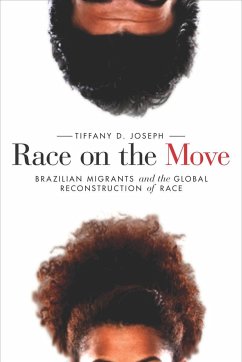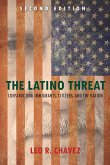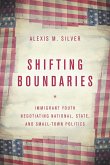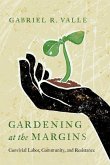- Gebundenes Buch
- Merkliste
- Auf die Merkliste
- Bewerten Bewerten
- Teilen
- Produkt teilen
- Produkterinnerung
- Produkterinnerung
Tiffany D. Joseph is Assistant Professor of Sociology and Affiliated Faculty of Latin American and Caribbean Studies at Stony Brook University.
Andere Kunden interessierten sich auch für
![China's Minorities on the Move China's Minorities on the Move]() Robyn IredaleChina's Minorities on the Move172,99 €
Robyn IredaleChina's Minorities on the Move172,99 €![The Latino Threat The Latino Threat]() Leo ChavezThe Latino Threat100,99 €
Leo ChavezThe Latino Threat100,99 €![Mafias on the Move Mafias on the Move]() Federico VareseMafias on the Move34,99 €
Federico VareseMafias on the Move34,99 €![China on the Move China on the Move]() C Cindy FanChina on the Move135,99 €
C Cindy FanChina on the Move135,99 €![Shifting Boundaries Shifting Boundaries]() Alexis M SilverShifting Boundaries111,99 €
Alexis M SilverShifting Boundaries111,99 €![Jesus Loves Japan Jesus Loves Japan]() Suma IkeuchiJesus Loves Japan130,99 €
Suma IkeuchiJesus Loves Japan130,99 €![Gardening at the Margins Gardening at the Margins]() Gabriel R ValleGardening at the Margins63,99 €
Gabriel R ValleGardening at the Margins63,99 €-
-
-
Tiffany D. Joseph is Assistant Professor of Sociology and Affiliated Faculty of Latin American and Caribbean Studies at Stony Brook University.
Produktdetails
- Produktdetails
- Verlag: Stanford University Press
- Seitenzahl: 240
- Erscheinungstermin: 25. Februar 2015
- Englisch
- Abmessung: 236mm x 154mm x 20mm
- Gewicht: 439g
- ISBN-13: 9780804792202
- ISBN-10: 0804792208
- Artikelnr.: 41751082
- Herstellerkennzeichnung
- Libri GmbH
- Europaallee 1
- 36244 Bad Hersfeld
- gpsr@libri.de
- Verlag: Stanford University Press
- Seitenzahl: 240
- Erscheinungstermin: 25. Februar 2015
- Englisch
- Abmessung: 236mm x 154mm x 20mm
- Gewicht: 439g
- ISBN-13: 9780804792202
- ISBN-10: 0804792208
- Artikelnr.: 41751082
- Herstellerkennzeichnung
- Libri GmbH
- Europaallee 1
- 36244 Bad Hersfeld
- gpsr@libri.de
Tiffany D. Joseph is Assistant Professor of Sociology and Affiliated Faculty of Latin American and Caribbean Studies at Stony Brook University.
Contents and Abstracts
Introduction: Migration and Racial Movement across Borders
chapter abstract
This chapter describes how racial ideals move across borders via
individuals who migrate between countries. This discussion is framed by
scholarly debates regarding racial frameworks in the United States and
Brazil and argues that migration can be used to comparatively examine race
in both countries using the experiences of Brazilian return migrants in the
city of Governador Valadares. The chapter introduces the theoretical
concept of the transnational racial optic and concludes with a brief
discussion of the author's positionality in conducting the study.
1The Town That Uncle Sam Built
chapter abstract
This chapter introduces readers to the city of Governador Valadares (GV).
It explores the history of the U.S. presence there and how migration has
transformed the city into a place where people, money, and culture flow to
and from Brazilian immigrant enclaves in the United States. The chapter
concludes with a discussion of how this transnational context shaped
Valadarenses' racial conceptions before migrating.
2Deciphering U.S. Categories
chapter abstract
This chapter illustrates how the transnational racial optic influenced
migrants' negotiation of U.S. categories. It explores their racial
self-classifications, interpretation of the Latino and Hispanic categories,
and perceptions of white racial classification in the United States and
Brazil. This chapter describes how migrants used Brazilian racial
classification norms to find their racial place in the United States.
3Navigating the Racial Divide
chapter abstract
This chapter delves into returnees' perceptions of and experiences with the
U.S. racial divide in terms of discrimination, interpersonal relationships,
and residential segregation. The discussion is framed by migrants'
comparisons of black Americans-whom migrants perceive as upwardly mobile
but racist-and black Brazilians-whom migrants perceive as socially
disadvantaged but less racist. Migrants discover that in spite of overt
racism in the United States, Americans of different races experience more
social mobility than Brazilians.
4Classification after the Return Home
chapter abstract
This chapter explores migrants' renegotiation of their racial and skin tone
classifications after their return migration and incorporates the
perspectives of nonmigrants. The chapter compares returnees' and
non-migrants' classifications and examines both groups' perceptions of the
relationship between sun exposure and skin color. This chapter shows that
migrants use U.S. racial classification norms to resituate themselves
within Brazilian categories.
5Making America in Brazil
chapter abstract
This chapter examines how returnees remit U.S. racial ideals to GV by
comparing returnees' and non-migrants' views of racial stratification in
Brazil. It explores differences in these groups' perceptions of racial
democracy, manifestations of racism, and black Brazilians. The chapter
illustrates how the transnational racial optic facilitated a shift in
returnees' racial conceptions after their U.S. migration experience. The
chapter concludes with a discussion of how both groups believe U.S.
migration has changed race relations in GV.
6Social Consequences of the Transnational Racial Optic
chapter abstract
This chapter discusses how race, socioeconomic status, and gender
influenced the extent to which the transnational racial optic influenced
returnees' racial conceptions. The chapter also examines how migration
altered their post-migration racial attitudes and behaviors, including
their interactions with non-migrants, their transnational investment in
whiteness, their opinion of Brazilian racial quotas, and their views of
civic engagement. The chapter concludes by discussing how the transnational
racial optic may facilitate a remaking of race in Brazil.
Conclusion: Toward Global Racial (Re)Formations
chapter abstract
The conclusion summarizes the book's theoretical contributions, namely that
return migration provides a nuanced vantage point for exploring the impact
of migration, how racial ideals in Brazil and the United States are
converging, and how the transnational racial optic can alter social
constructions of race via migration. These contributions are framed within
a discussion of how Brazilian migrants can enhance the study of the racial
assimilation of U.S. immigrants amid debates on the Latin Americanization
of U.S. race relations. The chapter then addresses how migrants'
transmission of racial ideals between countries has the potential to yield
global racial reformations, with implications for the study of racial
classification, stratification, and discrimination in various countries.
Introduction: Migration and Racial Movement across Borders
chapter abstract
This chapter describes how racial ideals move across borders via
individuals who migrate between countries. This discussion is framed by
scholarly debates regarding racial frameworks in the United States and
Brazil and argues that migration can be used to comparatively examine race
in both countries using the experiences of Brazilian return migrants in the
city of Governador Valadares. The chapter introduces the theoretical
concept of the transnational racial optic and concludes with a brief
discussion of the author's positionality in conducting the study.
1The Town That Uncle Sam Built
chapter abstract
This chapter introduces readers to the city of Governador Valadares (GV).
It explores the history of the U.S. presence there and how migration has
transformed the city into a place where people, money, and culture flow to
and from Brazilian immigrant enclaves in the United States. The chapter
concludes with a discussion of how this transnational context shaped
Valadarenses' racial conceptions before migrating.
2Deciphering U.S. Categories
chapter abstract
This chapter illustrates how the transnational racial optic influenced
migrants' negotiation of U.S. categories. It explores their racial
self-classifications, interpretation of the Latino and Hispanic categories,
and perceptions of white racial classification in the United States and
Brazil. This chapter describes how migrants used Brazilian racial
classification norms to find their racial place in the United States.
3Navigating the Racial Divide
chapter abstract
This chapter delves into returnees' perceptions of and experiences with the
U.S. racial divide in terms of discrimination, interpersonal relationships,
and residential segregation. The discussion is framed by migrants'
comparisons of black Americans-whom migrants perceive as upwardly mobile
but racist-and black Brazilians-whom migrants perceive as socially
disadvantaged but less racist. Migrants discover that in spite of overt
racism in the United States, Americans of different races experience more
social mobility than Brazilians.
4Classification after the Return Home
chapter abstract
This chapter explores migrants' renegotiation of their racial and skin tone
classifications after their return migration and incorporates the
perspectives of nonmigrants. The chapter compares returnees' and
non-migrants' classifications and examines both groups' perceptions of the
relationship between sun exposure and skin color. This chapter shows that
migrants use U.S. racial classification norms to resituate themselves
within Brazilian categories.
5Making America in Brazil
chapter abstract
This chapter examines how returnees remit U.S. racial ideals to GV by
comparing returnees' and non-migrants' views of racial stratification in
Brazil. It explores differences in these groups' perceptions of racial
democracy, manifestations of racism, and black Brazilians. The chapter
illustrates how the transnational racial optic facilitated a shift in
returnees' racial conceptions after their U.S. migration experience. The
chapter concludes with a discussion of how both groups believe U.S.
migration has changed race relations in GV.
6Social Consequences of the Transnational Racial Optic
chapter abstract
This chapter discusses how race, socioeconomic status, and gender
influenced the extent to which the transnational racial optic influenced
returnees' racial conceptions. The chapter also examines how migration
altered their post-migration racial attitudes and behaviors, including
their interactions with non-migrants, their transnational investment in
whiteness, their opinion of Brazilian racial quotas, and their views of
civic engagement. The chapter concludes by discussing how the transnational
racial optic may facilitate a remaking of race in Brazil.
Conclusion: Toward Global Racial (Re)Formations
chapter abstract
The conclusion summarizes the book's theoretical contributions, namely that
return migration provides a nuanced vantage point for exploring the impact
of migration, how racial ideals in Brazil and the United States are
converging, and how the transnational racial optic can alter social
constructions of race via migration. These contributions are framed within
a discussion of how Brazilian migrants can enhance the study of the racial
assimilation of U.S. immigrants amid debates on the Latin Americanization
of U.S. race relations. The chapter then addresses how migrants'
transmission of racial ideals between countries has the potential to yield
global racial reformations, with implications for the study of racial
classification, stratification, and discrimination in various countries.
Contents and Abstracts
Introduction: Migration and Racial Movement across Borders
chapter abstract
This chapter describes how racial ideals move across borders via
individuals who migrate between countries. This discussion is framed by
scholarly debates regarding racial frameworks in the United States and
Brazil and argues that migration can be used to comparatively examine race
in both countries using the experiences of Brazilian return migrants in the
city of Governador Valadares. The chapter introduces the theoretical
concept of the transnational racial optic and concludes with a brief
discussion of the author's positionality in conducting the study.
1The Town That Uncle Sam Built
chapter abstract
This chapter introduces readers to the city of Governador Valadares (GV).
It explores the history of the U.S. presence there and how migration has
transformed the city into a place where people, money, and culture flow to
and from Brazilian immigrant enclaves in the United States. The chapter
concludes with a discussion of how this transnational context shaped
Valadarenses' racial conceptions before migrating.
2Deciphering U.S. Categories
chapter abstract
This chapter illustrates how the transnational racial optic influenced
migrants' negotiation of U.S. categories. It explores their racial
self-classifications, interpretation of the Latino and Hispanic categories,
and perceptions of white racial classification in the United States and
Brazil. This chapter describes how migrants used Brazilian racial
classification norms to find their racial place in the United States.
3Navigating the Racial Divide
chapter abstract
This chapter delves into returnees' perceptions of and experiences with the
U.S. racial divide in terms of discrimination, interpersonal relationships,
and residential segregation. The discussion is framed by migrants'
comparisons of black Americans-whom migrants perceive as upwardly mobile
but racist-and black Brazilians-whom migrants perceive as socially
disadvantaged but less racist. Migrants discover that in spite of overt
racism in the United States, Americans of different races experience more
social mobility than Brazilians.
4Classification after the Return Home
chapter abstract
This chapter explores migrants' renegotiation of their racial and skin tone
classifications after their return migration and incorporates the
perspectives of nonmigrants. The chapter compares returnees' and
non-migrants' classifications and examines both groups' perceptions of the
relationship between sun exposure and skin color. This chapter shows that
migrants use U.S. racial classification norms to resituate themselves
within Brazilian categories.
5Making America in Brazil
chapter abstract
This chapter examines how returnees remit U.S. racial ideals to GV by
comparing returnees' and non-migrants' views of racial stratification in
Brazil. It explores differences in these groups' perceptions of racial
democracy, manifestations of racism, and black Brazilians. The chapter
illustrates how the transnational racial optic facilitated a shift in
returnees' racial conceptions after their U.S. migration experience. The
chapter concludes with a discussion of how both groups believe U.S.
migration has changed race relations in GV.
6Social Consequences of the Transnational Racial Optic
chapter abstract
This chapter discusses how race, socioeconomic status, and gender
influenced the extent to which the transnational racial optic influenced
returnees' racial conceptions. The chapter also examines how migration
altered their post-migration racial attitudes and behaviors, including
their interactions with non-migrants, their transnational investment in
whiteness, their opinion of Brazilian racial quotas, and their views of
civic engagement. The chapter concludes by discussing how the transnational
racial optic may facilitate a remaking of race in Brazil.
Conclusion: Toward Global Racial (Re)Formations
chapter abstract
The conclusion summarizes the book's theoretical contributions, namely that
return migration provides a nuanced vantage point for exploring the impact
of migration, how racial ideals in Brazil and the United States are
converging, and how the transnational racial optic can alter social
constructions of race via migration. These contributions are framed within
a discussion of how Brazilian migrants can enhance the study of the racial
assimilation of U.S. immigrants amid debates on the Latin Americanization
of U.S. race relations. The chapter then addresses how migrants'
transmission of racial ideals between countries has the potential to yield
global racial reformations, with implications for the study of racial
classification, stratification, and discrimination in various countries.
Introduction: Migration and Racial Movement across Borders
chapter abstract
This chapter describes how racial ideals move across borders via
individuals who migrate between countries. This discussion is framed by
scholarly debates regarding racial frameworks in the United States and
Brazil and argues that migration can be used to comparatively examine race
in both countries using the experiences of Brazilian return migrants in the
city of Governador Valadares. The chapter introduces the theoretical
concept of the transnational racial optic and concludes with a brief
discussion of the author's positionality in conducting the study.
1The Town That Uncle Sam Built
chapter abstract
This chapter introduces readers to the city of Governador Valadares (GV).
It explores the history of the U.S. presence there and how migration has
transformed the city into a place where people, money, and culture flow to
and from Brazilian immigrant enclaves in the United States. The chapter
concludes with a discussion of how this transnational context shaped
Valadarenses' racial conceptions before migrating.
2Deciphering U.S. Categories
chapter abstract
This chapter illustrates how the transnational racial optic influenced
migrants' negotiation of U.S. categories. It explores their racial
self-classifications, interpretation of the Latino and Hispanic categories,
and perceptions of white racial classification in the United States and
Brazil. This chapter describes how migrants used Brazilian racial
classification norms to find their racial place in the United States.
3Navigating the Racial Divide
chapter abstract
This chapter delves into returnees' perceptions of and experiences with the
U.S. racial divide in terms of discrimination, interpersonal relationships,
and residential segregation. The discussion is framed by migrants'
comparisons of black Americans-whom migrants perceive as upwardly mobile
but racist-and black Brazilians-whom migrants perceive as socially
disadvantaged but less racist. Migrants discover that in spite of overt
racism in the United States, Americans of different races experience more
social mobility than Brazilians.
4Classification after the Return Home
chapter abstract
This chapter explores migrants' renegotiation of their racial and skin tone
classifications after their return migration and incorporates the
perspectives of nonmigrants. The chapter compares returnees' and
non-migrants' classifications and examines both groups' perceptions of the
relationship between sun exposure and skin color. This chapter shows that
migrants use U.S. racial classification norms to resituate themselves
within Brazilian categories.
5Making America in Brazil
chapter abstract
This chapter examines how returnees remit U.S. racial ideals to GV by
comparing returnees' and non-migrants' views of racial stratification in
Brazil. It explores differences in these groups' perceptions of racial
democracy, manifestations of racism, and black Brazilians. The chapter
illustrates how the transnational racial optic facilitated a shift in
returnees' racial conceptions after their U.S. migration experience. The
chapter concludes with a discussion of how both groups believe U.S.
migration has changed race relations in GV.
6Social Consequences of the Transnational Racial Optic
chapter abstract
This chapter discusses how race, socioeconomic status, and gender
influenced the extent to which the transnational racial optic influenced
returnees' racial conceptions. The chapter also examines how migration
altered their post-migration racial attitudes and behaviors, including
their interactions with non-migrants, their transnational investment in
whiteness, their opinion of Brazilian racial quotas, and their views of
civic engagement. The chapter concludes by discussing how the transnational
racial optic may facilitate a remaking of race in Brazil.
Conclusion: Toward Global Racial (Re)Formations
chapter abstract
The conclusion summarizes the book's theoretical contributions, namely that
return migration provides a nuanced vantage point for exploring the impact
of migration, how racial ideals in Brazil and the United States are
converging, and how the transnational racial optic can alter social
constructions of race via migration. These contributions are framed within
a discussion of how Brazilian migrants can enhance the study of the racial
assimilation of U.S. immigrants amid debates on the Latin Americanization
of U.S. race relations. The chapter then addresses how migrants'
transmission of racial ideals between countries has the potential to yield
global racial reformations, with implications for the study of racial
classification, stratification, and discrimination in various countries.








